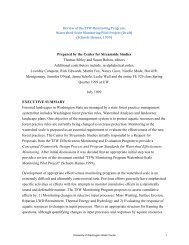Copyright 2012 Aileen M. Echiverri-Cohen - University of Washington
Copyright 2012 Aileen M. Echiverri-Cohen - University of Washington
Copyright 2012 Aileen M. Echiverri-Cohen - University of Washington
Create successful ePaper yourself
Turn your PDF publications into a flip-book with our unique Google optimized e-Paper software.
inhibitory inputs and ultimately decrease amygdala responsiveness, in addition to mediating<br />
extinction <strong>of</strong> fear responding (Quirk & Beer, 2006; Akirav & Maroun, 2007) suggesting PE may<br />
have an additive effect <strong>of</strong> changing pathological beliefs related to the trauma over SER. In<br />
addition, exposure therapy uses extinction principles in facilitating inhibitory learning (Rauch et<br />
al., 2003) subsequently inhibiting fear responses in PTSD. Therefore it may be more specific in<br />
directly targeting inhibitory processes (Craske et al., 2008) than SER that facilitates serotonin<br />
neurotransmission and is thought to bring about more broad changes in functioning (Brady et al.,<br />
2001; Davidson et al., 2001). Indeed, pharmacological therapies are heavily criticized to<br />
ameliorate target symptoms but not necessarily the underlying cause <strong>of</strong> the disorder, to suggest<br />
that it may not inhibit the original fear learning (Brady et al., 2001). PE and SER may use<br />
specific pathways on how they bring about therapeutic change, however ultimately follow a final<br />
common pathway in reducing amygdala reactivity (Rausch et al., 2003).<br />
This final common pathway may help explain the general pattern <strong>of</strong> increased attentional<br />
inhibitory control from pre- to post-treatment being modified by therapeutic modality and<br />
treatment response. Specifically, exposure therapy is thought to bring about therapeutic change<br />
through a top down modulation <strong>of</strong> amygdala activity whereas sertraline may influence bottom up<br />
modulation by the amygdala (Porto et al., 2009; Brady et al., 2001). In a fMRI study examining<br />
predictors <strong>of</strong> treatment recovery <strong>of</strong> cognitive behavioral therapy (CBT) for MDD, Siegle and<br />
colleagues (2006) found reduced subgenual cingulate cortex activity at pre-treatment for<br />
treatment responders <strong>of</strong> CBT for depression. The authors proposed that responders <strong>of</strong> CBT were<br />
those individuals with high emotional reactivity; therefore, emotion regulation strategies, a<br />
treatment component <strong>of</strong> CBT, may have facilitated control and regulation over their emotions.<br />
Similarly, in MDD, DeRubeis et al. (2008) reviewed studies that compared CBT and<br />
43
















